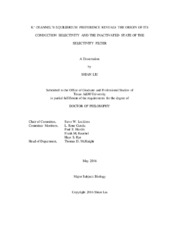| dc.description.abstract | K^+ channels are a class of membrane proteins that rapidly and selectively transport K^+ ions across lipid membranes. K^+ ions are concentrated inside the cell, and its efflux is responsible for the rapid repolarization during action potential. Given that K^+ channels play important roles in cell physiology, their activities are tightly controlled through a variety of features, of which high ion selectivity and gating are the two most common. The work presented in this dissertation will address two fundamental questions about them. First, what is the origin of the ion selectivity during conduction? Second, C-type inactivation is gating mechanism that takes place in the selectivity filter, and how is the C-type inactivated state of the filter differ from other functional states?
Ion selectivity is achieved through a highly conserved region in the channel named the selectivity filter, which is a queue of four binding sites observed in crystal structures of all K^+ channels. These sites are selective for K^+ over another abundant Na^+ ion at equilibrium, so a model based on the equilibrium selectivity was proposed to explain the conduction selectivity in K^+ channels. A recent study showed that eliminating sites from the filter of K^+-selective channels abolished their conduction selectivity, suggesting that these channels may have lost their equilibrium selectivity. To test the hypothesis, we measured the ion binding preference of K^+ channels and non-selective mutant channels. Unexpectedly, my results demonstrated that these channels have strong K^+ selectivity at equilibrium, suggesting that the conduction selectivity is likely derived from a blocking mechanism created by interacting ions inside the filter.
C-type inactivation reduces ion flow through the selectivity filter of K^+ channels following channel opening. Crystal structures of the open KcsA K^+ channel shows a constricted selectivity filter that does not permit ion conduction, which was proposed by others to be the inactivated conformation. However, recent work using a semi-synthetic channel that is unable to adopt the constricted conformation but inactivates like wild-type channels challenges this idea. I measured the equilibrium ion-binding properties of channels in three different conformations to differentiate their apparent binding affinities. My results revealed that the inactivated filter is more similar to the conductive conformation than the constricted conformation from an energetic point of view.
In this dissertation, I primarily applied isothermal titration calorimetry to measure the ion equilibrium preference to the selectivity filter, because it is a mechanism-free approach to detect the states of the channel in an aqueous solution. These data provide further constraints on mechanistic models of ion selectivity and inactivation in K^+ channels, which allowed to propose that the conduction selectivity of K^+ channels derives from ion interaction in the filter and that the inactivated filter resembles the conductive filter of the KcsA K^+ channel. | en |


